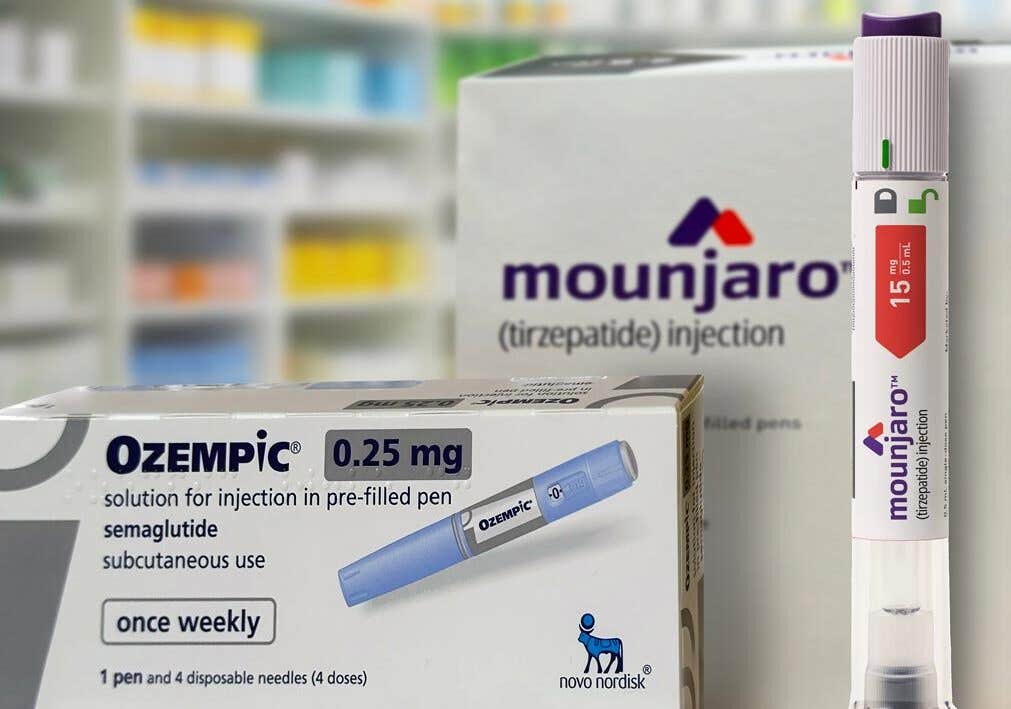First head-to-head trial compares tirzepatide and semaglutide – Results are in!
The study involved 751 adults with obesity but no type 2 diabetes. The participants were randomly assigned to take either tirzepatide or semaglutide.

Two drugs—tirzepatide and semaglutide—have shown striking results in helping people lose weight and keep it off. (CREDIT: CC BY-SA 4.0)
Over the past few years, a new class of injectable medications has changed the way obesity is treated. Two drugs—tirzepatide and semaglutide—have shown striking results in helping people lose weight and keep it off. But until now, no one had directly compared their performance in people without diabetes. A large clinical trial has now done just that—and the results favor tirzepatide.
Greater Weight Loss With Dual-Action Drug
The new study, led by Dr. Louis Aronne, director of the Comprehensive Weight Control Center at Weill Cornell Medicine, involved 751 adults with obesity but no type 2 diabetes. These participants were randomly assigned to take either tirzepatide or semaglutide at their highest tolerated doses. Over the course of 72 weeks, people on tirzepatide lost an average of 20.2% of their body weight, or about 50 pounds. Those on semaglutide lost 13.7%, around 33 pounds.
Tirzepatide, sold under the name Zepbound, activates two hormone receptors—GLP-1 and GIP—while semaglutide (Wegovy) only targets GLP-1. Both of these hormones help reduce appetite and regulate how your brain responds to food. But GIP receptors are also found in fat cells, which might explain why tirzepatide seems to produce better results.
“The pathways that regulate weight are incredibly complicated,” said Dr. Aronne. “Targeting more than one may pave the way to greater weight loss.”
A Well-Controlled Comparison
The clinical trial was sponsored by Eli Lilly, the maker of tirzepatide, and included researchers from NewYork-Presbyterian, the University of Texas, UCLA, University College Dublin, and 32 clinical sites across the United States and Puerto Rico. The study was published in the New England Journal of Medicine and presented at the European Congress on Obesity in Spain.
Participants in the trial had an average age of 44.7 years, a mean body weight of 113 kg (249 lbs), and a body mass index (BMI) of 39.4 kg/m². Most had been living with obesity for about 16 years, and nearly half had at least two health issues related to their weight.
Related Stories
Everyone in the trial received diet and exercise counseling along with the medication. The treatments were given once a week using labeled auto-injection devices, which meant that participants knew which drug they were getting. Though not blinded, the study was designed to reflect real-world conditions as closely as possible.
Both groups had similar side effects, mainly gastrointestinal issues like nausea and abdominal pain. These problems were usually mild or moderate and tended to happen during the early dose increases.
More People Reached Major Weight Loss Goals
Not only did people taking tirzepatide lose more weight overall, but more of them reached key weight-loss milestones. Nearly one-third of tirzepatide users lost at least 25% of their body weight. That’s double the 16% who reached that goal on semaglutide. A smaller group—almost 20%—on tirzepatide even lost 30% or more of their starting weight, compared to only 6.9% on semaglutide.
The study also tracked waist size. On average, those on tirzepatide saw an 18.4 cm (7.2 inches) reduction in waist circumference, compared to 13 cm (5.1 inches) for semaglutide. That difference of more than 2 inches is meaningful. Research shows that every 5 cm (2 inches) of added waistline raises mortality risk by 7% in men and 9% in women.
“These findings support the importance of aiming for waist reduction, especially in people with abdominal obesity,” said the authors.
Gender Differences and Real-World Relevance
Interestingly, women saw slightly better results than men with both treatments. This partly explains why the current trial showed lower average weight loss than previous studies, which had fewer male participants. In this trial, 35% of the participants were male, compared to about 20% in earlier research.
Still, the new findings line up well with results from previous trials like the SURMOUNT and STEP programs. These earlier studies also found higher weight reductions with tirzepatide than with semaglutide.
Dr. Aronne said the dual-action approach of tirzepatide is likely the reason for its stronger results. “Although it is a single molecule, tirzepatide pharmacologically activates two metabolic receptors,” he explained. This dual-agonism approach—targeting both GIP and GLP-1—seems to work better than the single-pathway method used by semaglutide.
Looking Ahead: Even More Powerful Treatments
While tirzepatide has raised the bar, scientists are already working on what comes next. Dr. Aronne and his team are testing a new compound called retatrutide, which targets three hormone pathways: GLP-1, GIP, and glucagon. Nicknamed “triple G,” this next-generation drug could lead to even greater weight loss and help people who don’t respond to current options.
“Even though drugs like tirzepatide and semaglutide work really well—better than anything we have ever seen—we still have people who don't respond to them,” said Dr. Aronne. “So moving forward, we want to keep trying to do better.”
Trials are also underway to test whether tirzepatide reduces the risk of heart attacks and strokes, as semaglutide has already been shown to do.
A Stronger Path to Health
The clinical benefits of significant weight loss go beyond looks or numbers on a scale. Reducing weight and waist circumference can lower blood pressure, improve blood sugar, and cut the risk of many chronic diseases. In this trial, both drugs helped improve these health markers, but tirzepatide’s added benefits could make it the top choice for many people with obesity.
Still, not every patient will need the most powerful drug to see improvements. Doctors will need to consider individual health goals, side effects, and affordability when choosing a treatment.
Importantly, the study included a diverse group of participants—nearly 20% identified as Black and about 26% as Hispanic or Latino—making the results more broadly applicable to people in the U.S. living with obesity.
“The study shows that tirzepatide was superior to semaglutide in reducing body weight and waist circumference,” said Dr. Aronne. “And that could make a real difference in how we approach obesity treatment.”
Note: The article above provided above by The Brighter Side of News.
Like these kind of feel good stories? Get The Brighter Side of News' newsletter.



